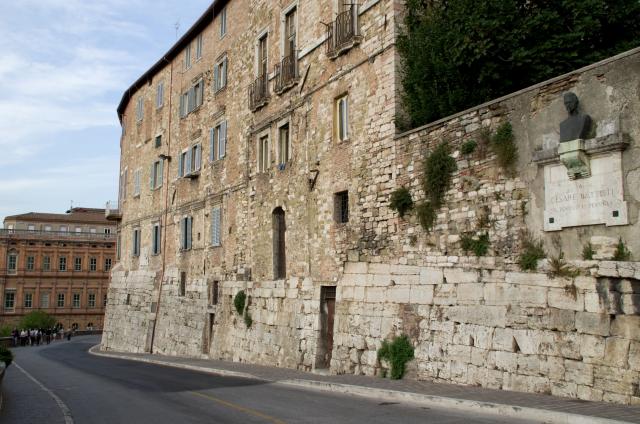Tour of Perugia’s Etruscan city walls
Etruscan Well

If you fancy taking a plunge into Perugia’s history by touring her original Etruscan city walls, you can follow surviving sections of the protective rampart built by the Etruscans in the 4th and 3rd centuries B.C which in some places surface to stand proud and can still be traced in others where Medieval fortifications were grafted onto them to form a three-leaved clover shape with a circumference of approximately three kilometres.
The departure point for this tour is the best-preserved portion of the walls where you can view finely-crafted courses of travertine marble on the external façade of the Arco Etrusco (Etruscan arch) before turning right along the well-preserved northern wall of the Etruscan rampart. As you mount the evocative Viale Cesare Battisti; skirting the valley towards Porta Trasimena (or San Luca) on your left there are string-course cornices where sentries once tramped their rounds. There may also have been another gate where the medieval archway leading into Via Appia now stands.
Below Via del Verzaro, mighty but irregular blocks of the wall resurface briefly although backing onto an embankment and serving as foundations. The only remains of the ancient city gate Porta Trasimena are its Etruscan impost blocks but, as you move on into Via della Cupa, the walls stand tall again as they follow the steep incline leading down to the Cupa depression were a small opening provided access to the city centre.
Close to where Arco della Mandorla stands today, a few ashlar blocks are all that remains of another of Perugia’s Etruscan city gates and, if you turn to your left, you may view a much-rearranged section of the wall still bearing valuable inscriptions referring to the Roman colony of Perusia.
Porta Marzia is a monumental gate facing and mirroring the Arco Augusto. It was moved forwards a few metres from its original site and integrated into the Rocca Poalina fortress but a few ashlar blocks are still visible on the inside of the entrance archway. The wall’s course followed Via Sant’Ercolano where another rearranged section can be seen near the church.
Piazza del Sopramuro (now known as Piazza Matteotti) took its name [above the wall] from where medieval ramparts were built upon Etruscan ones; from there the perimeter wall continued beneath what are now Via Cartolari and Via della Viola to resurface in Via Alessi and in Via Sdrucciola, where its remains form an angle with Porta Sole, and finally ran back up towards Arco Etrusco which is where our tour began.